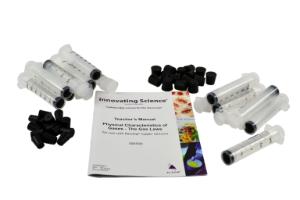Crush It In Your Chemistry Class with this Crushing Can Activity
A hands-on way to help the students in your class investigate how gases behave when exposed to temperature, pressure, and volume changes.
Middle and High School
The students in your class will be crushed if they miss out on exploring the exciting scientific topics demonstrated by the Crushing Can activity. This activity supports lessons on important concepts like atmospheric pressure, state change, kinetic molecular theory, and more. Understanding gases is the perfect pathway to students’ understanding of more complicated states of matter. The Crushing Can demonstration is a hands-on way to help the students in your class investigate how gases behave when exposed to changes in temperature, pressure, and volume. So, download it now because the pressure is on!
What is a gas?
A gas is a form of matter that doesn’t have a defined shape or volume. A pure gas may be made up of individual atoms (e.g., a noble gas like neon), elemental molecules made from one type of atom (e.g., oxygen), or compound molecules made from a variety of atoms (e.g., carbon dioxide). A gas mixture, such as air, contains a variety of pure gases.1 These molecular combinations are a source of scientific inspiration.
What are gasses used for?
Gas is no laughing matter. Well, it is if we’re talking about Nitrous oxide (N2O); when used as a sedative in the dentist’s office, patients may ask, “Is this real life?” making everyone around laugh hysterically. But, seriously, without gases, there would be no life on Earth. Gases have an endless number of important applications; here are just a few:
- Oxygen (O2): basis for virtually all anesthetic techniques, welding, BREATHING!
- Nitrogen (N2): food preservation, fire suppression
- Helium (He): balloons, cooling MRI magnets
- Argon (Ar): welding, thermal insulation in energy-efficient windows
- Carbon dioxide (CO2): carbonated soft drinks, refrigerants, fire extinguishers
- Acetylene (C2H2): welding, production of other chemicals used in perfumes
- Propane (C3H8): fuel for heat, a raw material for making plastics and other compounds
- Butane (C4H10): fuel for lighters and torches, a propellant in aerosols
- Freon (various chlorofluorocarbons): coolant for air conditioners, refrigerators, freezers
Download the Crushing Can activity; It’s a great way to get students interested in learning more about this form of matter essential to their everyday lives. This activity has been certified “Best in Gas.”
References: 1. Gas - Wikipedia. https://en.wikipedia.org/wiki/Gases
Recommended products:
[StartProductBlock]

Physical Characteristics of Gases Lab Activity
Students discover the relationship between gas volume, temperature, moles, and pressure (Boyle’s, Charles’, and Gay-Lussc’s gas laws).
[EndProductBlock]
[StartProductBlock]

Gas Laws Demonstrator
Students quickly and easily visualize the relationship between volume, temperature, and pressure when one of these variables is constant.
[EndProductBlock]
[StartProductBlock]
Kinetic Theory Model
Study the motion and behavior of gas molecules with this intriguing demonstration.
[EndProductBlock]
[StartProductBlock]
Bunsen Burner with Flame Stabilizer and Gas Adjustment
Allows for both air and fuel adjustments and throttle control via a gas adjustment needle valve. The flame stabilizer comes standard. Available in natural gas and liquid propane variants.
[EndProductBlock]
